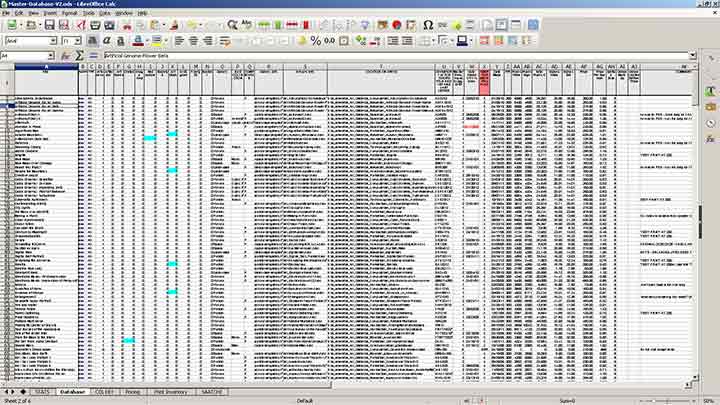My Art Workflow - The Management Bits

LibreOffice Calc Art Inventory Database
Photography workflow is a major point of discussion amongst photographers. The workflow concept typically addresses the steps from preparing to take a photograph to taking the photograph through subsequent image processing and on to the creation of the final printed image. Traditional artists have their own set of workflows that are dependant on their medium. Likewise digital artists have their own set of unique workflows that serve to identify the steps of creation and the tools used at each stage.
For me, the creative component of my workflow is the exciting and most challenging part because it is that portion in which creativity plays the key role. In my case, that creativity includes the creation of programs that I then use to create my artworks. Not so fun is the necessary downstream data management steps that are associated with the cataloging/recording/business end of the art and photography business.
For me, the key part of this downstream management process was the creation of spreadsheets to inventory my artwork, track limited edition prints, and record pricing. To manage all this data I had considered using database software. A time cost/benefit analysis led me to conclude that simply using multiple spreadsheets in conjunction with a database system's query capabilities was better than implementing a complete database system. In turning to a spreadsheet solution I started out using Microsoft Excel but then migrated to OpenOffice Calc before finally migrating to LibreOffice Calc. My methodology is to use spreadsheets for data storage and some analysis while taking advantage of database software's ability to access that data, run queries, and generate reports. In the case of LibreOffice Calc, I use the LibreOffice Base database software to connect to my spreadsheets.
In creating a worksheet to serve as the master record for my art (and photography), I set about the task of identifying what pieces of information I needed to track. The image I've used to illustrate this article is a screenshot of my main inventory worksheet scaled down so that a majority of the columns/fields were shown on-screen. Some of the fields included in this main inventory worksheet are artwork title, computer directory location, date the art was created, the dots per inch (DPI) that the art is printed at, the artwork's width and height in both pixels and inches, limited edition print quantity, an inventory id, a limited edition print id, price, a calculated price per square inch to track pricing consistency, the date the artwork was added to my artsnova.com web site, the artwork's url on artsnova.com, and fields for print-on-demand web sites where open edition prints are available. I then use secondary worksheets to track things like a) data related to art on POD sites (like artflakes.com, crated.com, imagekind.com, redbubble.com, etc.); b) limited edition prints; c) commissions; d) auction pricing. In all, there is a fair amount of record keeping that goes into tracking my artwork. It's not fun but it is essential to keep good records.
In addition to recording data about each artwork, there is also the process of creating multiple representations of each artwork for the various platforms on which it will appear. Examples are:
- gallery and non-cropped thumbnail images for display on my Artsnova web site.
- cropped thumbnails for uniformly sized POD (print on demand) portfolio indices.
- custom sized and watermarked images for sharing on various social media platforms.
- larger sized images for inclusion in my digital portfolio (for viewing on either my laptop or tablet).
To facilitate the production of these various images I have created a number of Photoshop actions to insure consistency and to automate the process as much as possible. With respect to the cropped thumbnails for uniformly sized POD portfolio indices item above, this is a recent addition to my workflow done to facilitate the creation of mobile-friendly gallery pages. These uniformly sized images make for a more predictable reflowing of the images when the display screen is resized. More importantly, it significantly reduces the amount of code I have to write to support that reflowing (yes, I do all my own web work). Specifically, I wanted to create gallery index pages of the art and photography that I sell on third party print-on-demand (POD) platforms. An example of the first index page so created is Art and Photography Open Edition Prints on Crated.com (out of business as of 7/31/2017).
And there you have two of the key components of the business end of my digital art workflow from the aspect of data management and supporting image creation. There are other components of my work flow, like creating web pages and posting to POD sites, but those tasks are common to all artists posting their work to the Internet, with the details being dependent on the platform to which they are posting.
Unfortunately my documentation of my actual artwork creation process is quite haphazard. In all honesty, I do not keep good records as to the specifics of how I created an artwork. I generally only know what program I used for its creation. With respect to my own programs, this is important because of the wide variety of programs I've written and their less than perfectly clear names. Examples of a few of my program names are Abstract-Particle-Painter, Circle-Bots-1, Dynamic-Shape-Painter, Noll-Vertical-Horizontal-3D, Simple-Attractor-Force, Visualizer-3, and X-and-Y-Cycles. I should better document the creation process for each artwork but my time is a limited commodity and not documenting the tasks I perform in the creation of an artwork regularly loses out to other demands on my time.
If you can't measure it, you can't manage it.
A quote widely attributed to management guru Peter Drucker - even though he never actually said it.



